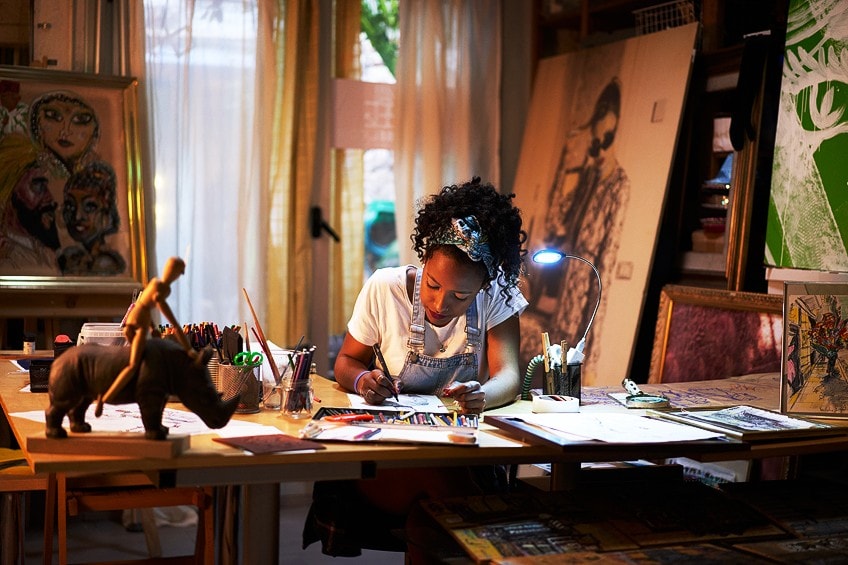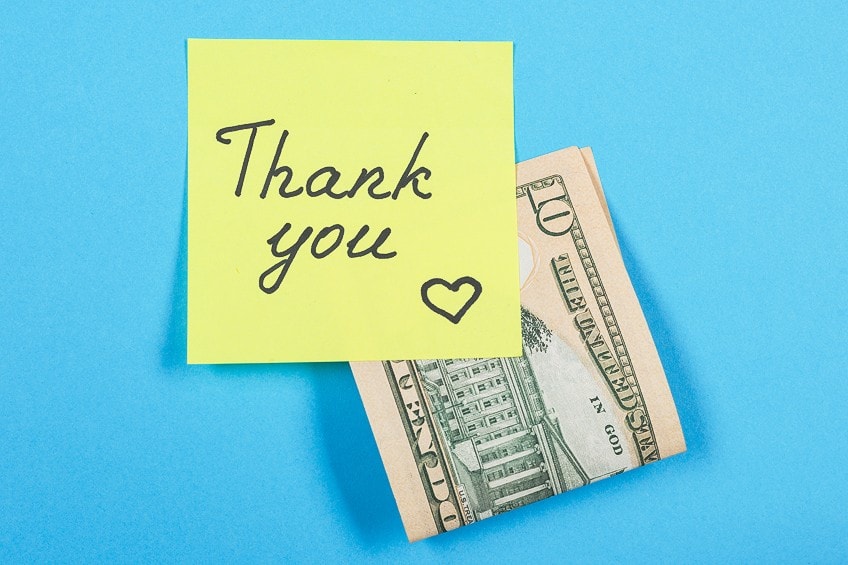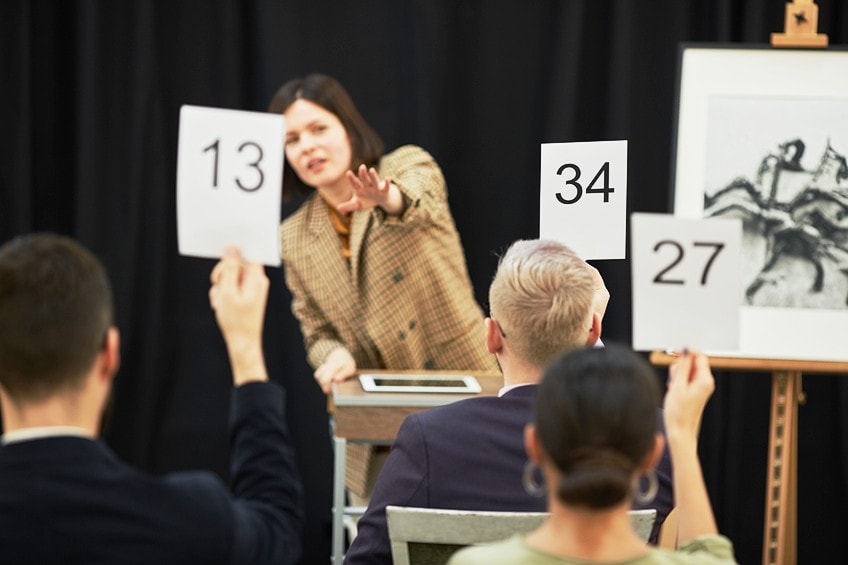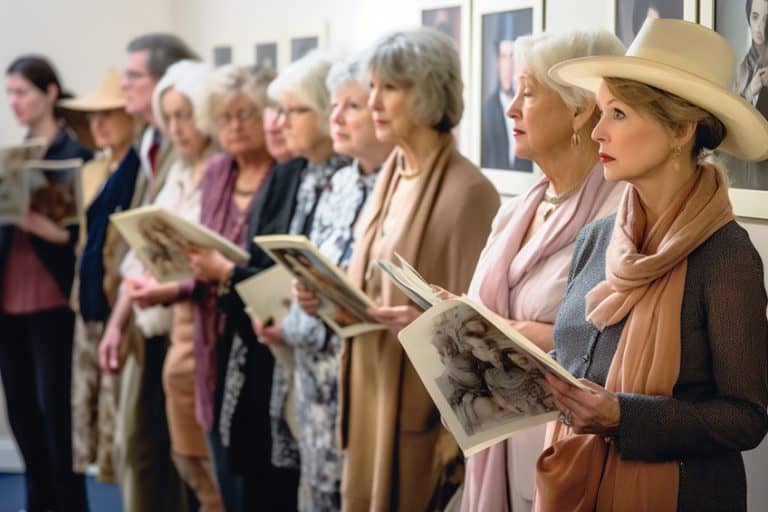What Are Art Commissions? – An Easy Guide to Art Commissions
Art commissions are an excellent way for artists to create more financial security in their practice. Selling a commissioned art piece, however, involves extra admin and clear communication between you and the client. This article will look at how to get art commissions, how to set up an art commissions website, and how to price commissioned art. It aims to provide a clear guide to answer the questions, what are art commissions, and how does art commission work?
Table of Contents
What Are Art Commissions?
Not to be confused with the commission a gallery takes on art sales, art commissions are special requests by a client for an artist to create a new piece specifically for the client’s needs. Gallery commission is a percentage of the selling price a gallery takes for their work on marketing and showing the artist’s work (normally 20 to 50% of the selling price).
Commission art is the process of a buyer reaching out to an artist to hire them to create a new piece that the client will definitely pay for and take.
Art commissions, for example, include the buyer requesting the artists to make a painting in their style in a specific style, redoing a painting the client likes in a different palette or size, and creating an artwork that can be used for a business’s marketing purposes, using the artist’s style on a specific subject matter the client wants and so on.

Buyers often commission a painting, for example, because they like the style of the artist but cannot afford any of their existing pieces, want a specific subject matter, or missed out on buying a painting at an exhibition that sold out. Businesses often commission artists to create content they can use as part of their brand identity or in a specific project or campaign.
Art commissions are often also requested when the buyer wants something personal created by a specific artist, like a painting of their house, dog, or family.
The artist will often limit what can be requested as a commission, by specifying the medium, style, and subject matter limitations on their art commissions website. An artist needs to get clear on what it is the buyer wants, and the terms of the commission, and draw up a contract that holds the buyer accountable to purchase the piece in full when it is done.
How Do Art Commissions Work?
An artist needs to make themselves available to receive commission requests by adding a page or art commissions website to their marketing. If you are not interested in doing commission paintings, for example, but want to do digital commissions you need to state this clearly.
This way, the request you will receive from clients will already be filtered and clear (see the section on art commissions websites for more on how to communicate your commission process to your audience).
Get Clear on the Vision
Once a client has reached out to you, you need to set up a call or meeting. You need to have a one-on-one discussion in which you make sure you clearly understand what the buyer desires and if you are the right artist to create their desired artwork for them.
At this stage, you should clearly communicate your process of creating commissioned art.

Take Only the Right Clients
Do not take clients that want something you have not done before and feel uncertain about, or that is not in your style. Art commissions take a lot of extra time and you will save yourself a lot of trouble and potential disappointment by staying with what you know you can do. Besides the extra time art commissions take, the process also involves a lot of expectations. The buyer knows they will receive an artwork and has to commit financially from the beginning.
They have an idea in mind and if they request something from you that is not similar to your artistic style, they might feel disappointed when the artwork is done.

If you take on work you do not want to do, you also cannot use the finished art commissioned as marketing to generate more interest for the commissions you want to be doing. Your personal practice is where you can experiment with your style, medium use, and subject matter.
But art commissions should be straightforward and easy to do to ensure client satisfaction.
Generate Practice Sketches
After you have made sure you and the client clearly understand each other, you can draw up a few practice sketches for the buyer to look over. Do not spend too much time on this, as the client has not yet committed to paying for your time. You can also communicate to the client that this part of the process is just a quick check-in to see if your visual idea aligns with what the client wants.
Limit the amount of planning to, for example, two compositional options and one alteration request from the client’s side before you give them a contract to sign, sealing the deal.

You can decide how much back-and-forth you are willing to do in this part of the process, but make sure that you take care of your time. Time is money for an artist and if you allow your clients to alter the planning of the commission too many times there is still a risk that they might pull out and then you will not be compensated for your time. You can also choose to make the planning and alterations of planning sketches part of the paid package of the final commissioned artwork.
This will ensure that your time is not wasted, but could also discourage uncertain buyers to commit before they have seen your visual interpretations of their request.
Set Up a Contract
When you are clear on the buyer’s request and have done some practice sketches to make sure both of you are on the same page, you can draw up a contract reflecting the terms of the commissioned art piece. You need to include an overview of what you will create. This is a paragraph on the buyer’s request and how you understand it. Describe the artwork in as much detail as possible.
The contract needs to have the payment breakdown (see the section below for more on this), a timeline of the creation of the commissioned art piece, planning material, as well as copy and exhibition rights.
Include everything in the timeline of your agreement, like how long it will take to turn around the contract, produce the work or more practice sketches if requested, a payment schedule as well as drying and shipping time if needed. In an agreement like this, always give yourself a bit more time to produce the work than it takes. This will cover your basis if you make mistakes, struggle with the production, or need more artistic freedom to explore the piece in the process.

Give the buyer an idea of the different stages of the process, for example, include the research of the subject matter, artist references as well as medium exploration. This will give the buyer an idea of why the commissioned art is slightly more expensive than your spec art. Make sure you go through this checklist before starting with the commissioned art piece:
- Define both parties (the artist and collector): Clearly describe the commissioned work to be created — exactness is important.
- Payment agreement: Standard commission payments require the buyer to pay 50% upon signing the contract, and the rest (50%) upon completion (before shipping and delivery) — DO NOT deliver a commissioned artwork until it is fully paid for.
- Visual planning and references: At least include 1-2 similar works next to the sketches of the suggested composition.
- Artwork rights: Make sure you clearly state that you, the artist, reserve the reproduction rights, as well as exhibition rights with the collector’s permission.
- Signatures: Make sure both parties sign and that each has a copy of the contract before you start creating the art piece.
How to Price Commissions Art
In understanding how to price commissions art you need to consider what you want to achieve with this aspect of your business. If you want to create financial stability in your practice, you need to create market interest so buyers will know and start associating you with art commissions.
If you want to generate interest in a specific style you work in, you need to market personalized examples of these art commissions so buyers can see what it is you do in this area of your practice.
For example, if you want people to commission paintings of the guests attending their wedding, but are not interested in painting their dogs, you need to be clear on this. These considerations can influence how you price your art commissions, but can also lead you to create commission packages and sales that can encourage buyers to hire you.

A commission pricing package is a deal that encourages the buyer to purchase a specific set of art products. For example, if they want to commission paintings of their wedding guests you can offer a sliding scale price that decreases slightly for higher amounts of guests. If they want to commission paintings of their home, you can offer a complimentary small sketch of the garden as well. These sales or pricing campaigns can be an incentive for clients to choose to hire you above other artists.
Generally, buyers are expected to pay 50% of the agreed total price upon signing the contract.
This ensures their commitment, and covers the artist’s initial costs as well as provides income support for the artist while setting aside special time to work on the commissioned art piece. You can consider charging slightly more for commissioned art pieces than your spec art.

You will be doing extra paperwork in setting up the contract, will have to meet with the buyer (online or in person), do research in the planning phase, and will have to spend extra time in your studio to create the artwork besides the other independent artworks you might be working on.
If the timeline on your contract reflects this, the buyer should understand why your price is slightly higher than other finished work.
Do not make the difference in the prices of your commissions and spec art too high at the beginning of your career, as it might discourage clients. However, as your business grows, your art sells more and your time becomes more valued, commissioned art pieces should become the most expensive kind of request a client can hire you for.
The Process
After the client has signed the contract and paid 50% of the total price, you can start the creation process. You can choose whether you want to share images of the unfinished work with the buyer, but you have to ask for permission from the client before you share your process or even the final work on your social media and website.
Commissioned art is often personal and some collectors do not want to be mentioned as the buyer of art.

Make sure you know their preferences. Also consider whether you want to share the process with them, as they might become attached to a certain aspect of the artwork before it is done. If you do not want to share your progress with the client, state this in your contract.
Alterations
After the work is finished, and if the contract includes the option for the client to ask for alterations, you can start with adjustments if there are any. If you include the option for the client to request alterations, make sure you protect yourself by capping the amount.
Also include an extra timeline for these alterations.
Full Payment and Shipping
Only after the alterations and the completion of the commissioned art piece, you can invoice the buyer for the last 50% of the painting. Once the payment is received, you can wrap and ship the art. Consider asking the buyer to send you pictures of the artwork installed in their home.
This is so you can include it on your art commissions website.
How to Get Art Commissions: What to Include on an Art Commissions Website
Creating an art commission website, or at least a page on your website solely focused on commissions is a good idea. This way, you can give interested clients examples of previous commissions, list limitations of commission requests as well as detail the entire process from start to finish all in one place. If you use SEO settings, you can also generate traffic to this page. Use the breakdown above on how art commissions work to detail your process.
You can add a booking form so clients can log their requests straight from the page.

You could also consider running a competition on your website and social media with a free commission slot (with size, subject matter, and medium limitations) as the prize. Encourage your audience to sign up for your newsletter or share your content to enter.
This way, you will create excitement and interest in your commission work as well as grow your online audience.
Not Interested in Commissions?
If you are not interested in doing commissions, it might be a good idea to direct the requests you receive to an artist or friend you know. This way, you help another artist build their business. If you know an artist that works in a similar style to you, you could even propose that you get a small commission percentage of the clients you direct to them.
However, at the beginning of your career, it is a good idea to take commission requests even though you do not want to do it forever.

It will help you learn how to engage and negotiate with clients and expose you to business opportunities. Commissioners are often so impressed with their personalized artwork that they tell their friends and family about you. This generates interest and potential future clients for you.
Getting art commissions can bring stability to your art practice and encourage more people to buy your art. You need to communicate to the world that you are open and available for commission requests, an art commissions website is a brilliant platform for this. You also need to consider pricing, the clarity of the vision, and a timeline breakdown when you do commission art pieces. This takes extra time and research, but art commissions are a wonderful way to interact with your audience and make your art more desirable.
Frequently Asked Questions
What Are Art Commissions?
Art commissions are special requests by buyers for you to produce a specific work, in a specific style, medium, and subject matter. This can include personal requests like painting the buyer’s family, dog, or home or business requests like painting a logo, T-shirt design, or illustrations for a website. The artist then takes out special time to create the work and the agreement is often binding by contract.
What Is an Art Commissioner?
The commissioner is the client that requests an artist to make a specific work. Art collectors often become commissioners when they like an artist’s work but missed out on buying the artwork they liked or want the art piece in a specific size or color pallet. Interior designers are often also art commissioners as they want art that matches the design of houses they are working on. In an art commission contract, the buyer can be referred to as the Commissioner or Collector.
Can I Ask an Art Commissioner to Pay for Their Artwork Upfront?
The general rule is that the commissioner pays 50% of the total upon signing the contract and 50% upon the completion of the work (before it is shipped). This keeps the client and artist safe and ensures the artist completes the work before receiving the full amount. It might compromise your professional integrity if you ask the commissioner to pay the full amount before you start creating the art piece.
How Do I Protect Myself in Commission Requests?
You should always draw up a contract with the clear terms of the commission. Specify that you retain the right to reproduce the work and exhibit it (if the owner agrees). Specify the payment schedule for the art piece, as well as the timeline of making the work. Make sure the contract is clear and reflects all aspects of the commission. That way, you will be protected. Never start a commission before the client has paid 50% of the agreed total. Never ship a finished commission before the client has paid the full amount.
Nicolene Burger is a South African multi-media artist, working primarily in oil paint and performance art. She received her BA (Visual Arts) from Stellenbosch University in 2017. In 2018, Burger showed in Masan, South Korea as part of the Rhizome Artist Residency. She was selected to take part in the 2019 ICA Live Art Workshop, receiving training from art experts all around the world. In 2019 Burger opened her first solo exhibition of paintings titled, Painted Mantras, at GUS Gallery and facilitated a group collaboration project titled, Take Flight, selected to be part of Infecting the City Live Art Festival. At the moment, Nicolene is completing a practice-based master’s degree in Theatre and Performance at the University of Cape Town.
In 2020, Nicolene created a series of ZOOM performances with Lumkile Mzayiya called, Evoked?. These performances led her to create exclusive performances from her home in 2021 to accommodate the mid-pandemic audience. She also started focusing more on the sustainability of creative practices in the last 3 years and now offers creative coaching sessions to artists of all kinds. By sharing what she has learned from a 10-year practice, Burger hopes to relay more directly the sense of vulnerability with which she makes art and the core belief to her practice: Art is an immensely important and powerful bridge of communication that can offer understanding, healing and connection.
Nicolene writes our blog posts on art history with an emphasis on renowned artists and contemporary art. She also writes in the field of art industry. Her extensive artistic background and her studies in Fine and Studio Arts contribute to her expertise in the field.
Learn more about Nicolene Burger and the Art in Context Team.
Cite this Article
Nicolene, Burger, “What Are Art Commissions? – An Easy Guide to Art Commissions.” Art in Context. September 29, 2022. URL: https://artincontext.org/what-are-art-commissions/
Burger, N. (2022, 29 September). What Are Art Commissions? – An Easy Guide to Art Commissions. Art in Context. https://artincontext.org/what-are-art-commissions/
Burger, Nicolene. “What Are Art Commissions? – An Easy Guide to Art Commissions.” Art in Context, September 29, 2022. https://artincontext.org/what-are-art-commissions/.











